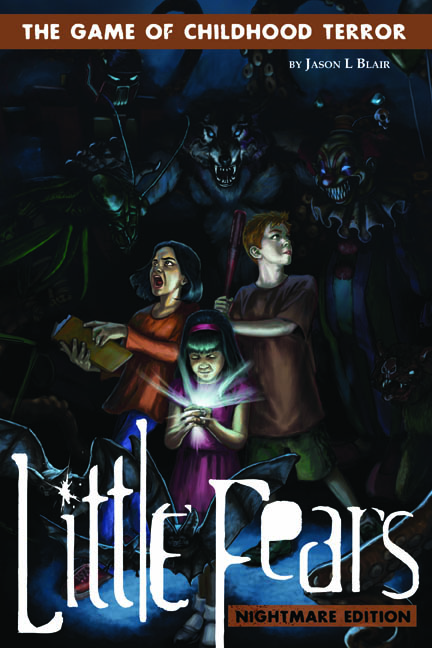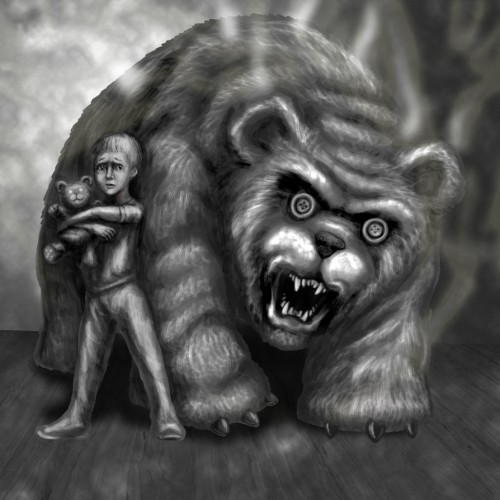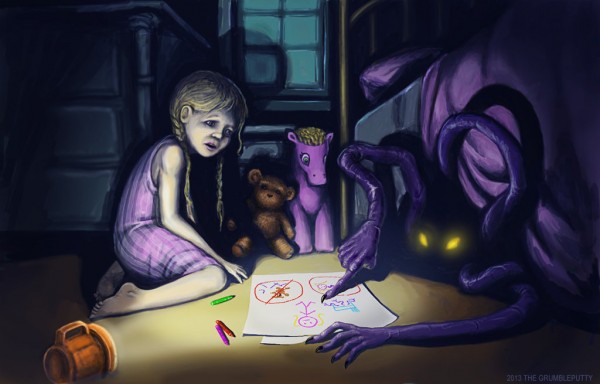You Should Be Playing…
Little Fears
We forget things when we grow up. We put aside the foolishness of our childhood, and shield our minds in the hard won armor of reason and knowledge. We forget how to believe without reservation, to trust without hesitation, and to fear without explanation. While some might say that this is for the worse, what we forget is how scary and large the world truly is. We forget about the monsters who lurk on our thresholds, hidden under our beds, and waiting in our closets. We tell ourselves that the monsters we believed in with all our hearts when we were children were never real, and we were never in any true danger.
We are wrong.
 Little Fears is a roleplaying game of childhood innocence and terrible monsters. Originally published in 2001 by Key 20 Publishing, it was written and designed by Jason L Blair. The game setting and rules were updated in 2009 with the release of Little Fears: Nightmare Edition by FunSizedGames. Little Fears: Nightmare Edition clarified the rules and removed some of the more controversial subject matter.
Little Fears is a roleplaying game of childhood innocence and terrible monsters. Originally published in 2001 by Key 20 Publishing, it was written and designed by Jason L Blair. The game setting and rules were updated in 2009 with the release of Little Fears: Nightmare Edition by FunSizedGames. Little Fears: Nightmare Edition clarified the rules and removed some of the more controversial subject matter.
The game was nominated for Best RPG and Game of the Year at the 2001 Origins Awards. An anniversary edition, Happy Birthday, Little Fears was released in 2011. Paperback copies of the game MSRP for $25 and can be found at gaming stores or directly through the game’s website. Digital copies can also be ordered through the game’s website, and separately through DriveThruRPG.
In Little Fears, one plays a child between the ages of six and twelve, confronting the terrors that only they can perceive. To these children, the monsters that exist in the world are very much real, and are capable of all the myriad terrible things that can be imagined. These monsters are drawn to the children who know of them, seeking to feed upon and further the unbridled fear that has called them into being. While some monsters can cloak themselves as mundane things, such as an angry dog or a strange janitor, most simply exist in a manner inimical to common reason and rationality. The worst of the monsters are the ones who seek to carry the children off to Closetland, a mysterious alternative dimension created from the dreams of the sleeping world.
You Just Have to Believe
The children of Little Fears are not entirely powerless, however. Children are far more resourceful and clever than the unhearing adults around them give them credit for. When faced with a dangerous situation, they can reach inside themselves and find the strength to fight back. This strength is the very same power which draws the monsters to them, the very same thing that causes monsters to exist in the first place. The children of Little Fears can shape the world with the power of their Belief, working magic with lucky coins and working rituals they read about in comic books. Their Belief in the love of their departed great-grandmother can turn away monsters hungry for their flesh, and their Belief in a werewolf’s vulnerability to silver can turn a silver dollar from a slingshot into a deadly projectile.
It is the power of Belief that provides Little Fears with the best conflict of a child’s existence. While Belief can make miracles happen, children often are defined by what they cannot do. They cannot simply disappear for days at a time, hunting demon coyotes in the woods, without their parents noticing. They cannot drive a car to escape an owl the size of a dinner table looking to snatch them up in their claws. They cannot skip school and melt the copper off pennies to lay a trap for the ghost who rode lightning without running afoul of a truancy officer. Some cannot even reach the top shelf of the cabinet to get their favorite cereal. Belief can make an ancient and terrible vampire stop its tracks, forcing it to flee before a pair of crossed fingers, but it can do nearly nothing against the mundane threats of cavities and curfews. Saddest of all, it is this very Belief that must fade for the child to grow up.
Gameplay
The rules of the two editions of Little Fears are different enough to be more of a systemic overhaul than a straight update. With Nightmare Edition being the newer iteration, and having been released digitally for free during Free RPG Day this year by DriveThruRPG, access to that set of rules is much easier to come by. It is the product line the author intends to proceed with, and it also happens to be the more inventive and playable version of the rules, with the monsters having much more clearly defined attributes and means of being defeated. Little Fears Nightmare Edition uses the Top 3 System, where a set of six sided dice are rolled, and the players keep their best three. They add the total together and compare it against a target number. If they meet or beat it, their action was successful. The more the roll exceeds the target number, the greater the level of success. Conversely, the greater the amount the roll fails by, the greater the negative consequences of that failure are. Opposed actions cause a roll from each player, with the highest total being the winner, with the usual degrees of success and failure.
 It is through Little Fears method of character creation where the game’s skill at incorporating its themes and language shines. Players build children between the ages of six and twelve, with younger children having more Belief, while older children having more points to spend on their Abilities.
It is through Little Fears method of character creation where the game’s skill at incorporating its themes and language shines. Players build children between the ages of six and twelve, with younger children having more Belief, while older children having more points to spend on their Abilities.
As a result, older children are more capable of holding their own in most situations while younger children can work the wonders of Belief when they need to. Little Fears uses verbs for its Abilities, making it clear just what each allows a child to do. Move helps you move. Fight helps you fight. Think, Speak, and Care all do exactly why they say they do. While some conflict within any system is inevitable, Little Fears’ Abilities are extremely intuitive and simple to grasp.
The simplicity of the rules allow for quite a fast paced game. Modifiers affect the number of dice rolled and are usually very descriptive. The specificity of modifiers to a roll keeps them from bogging down game play, and their evocative descriptions inform the narrative of a scene. Children also possess Qualities, which serve to provide modifiers to rolls. A child may have a modifier Quality of “I run faster when scared (Move +1)”, allowing them to roll an extra die on Move challenges when they are scared, while a monster having a Weakness of “Cannot stand bright light (-2)” gives it an obvious and exploitable vulnerability. Little Fears Nightmare Edition clarifies the process of how to build monsters, giving them the Strengths and Weaknesses in the same descriptive variety as the player characters. Even then, all the modifiers in the world only increase a pool of dice from which only the three best will be picked. This keeps the game’s target numbers at an easily predictable and reliable curve.
Every child has some good Qualities, such as “I can talk to adults (Speak +2)” or “I know Kung Fu (Fight +2)”, and some bad Qualities, such as “It’s hard for me to think when I am scared (Think -2)” or “I don’t like littler kids (Care -1)”. Little Fears has several derivative Abilities, giving a child three different status tracks as well as their starting Belief. Wits covers how scared a child is, Health covers how hurt the child is, and Soul measures the strength of their spirit. All three can be damaged by monsters and other hazards of being a child. The more Belief a child has, the more Stuff they start with. Stuff serves the role of magic items, representing the talismans children cling to for protection and power. Finally, character creation finishes with a series of questions which fill out the world around the child, giving them their goals, families, and other details which inform both the player and the game master as to the child’s journey through the story.
Childhood is a terrifying and wonderful experience. While it is common to remember the good times of childhood and to let go of the bad times, both take an equal hand in shaping us into the adults we become. While we may lack many things as children, that terror and wonder is something all children possess in spades. Little Fears is a game that explores both sides to that coin, filling the world with terrible monsters while giving children the power to fight – and possibly defeat – them. The only adversary they cannot fight is the unstoppable wall of time, pushing them towards adulthood where reason and knowledge hold sway in the cold ashes of where belief once flourished. But in those ashes, we can pretend to be children again, and remember the feel of that wonder once more.
And that is why you should be playing Little Fears.
David Gordon is a regular contributor to the site. A storyteller by trade and avowed tabletop veteran, he is always on the lookout for creative tabletop games. He can be reached at dave@cardboardrepublic.com.
You can discuss this article and more on our forums!
Photo Credits: Little Fears book cover by Jason Blair; Belief and Complex Negotiations by grumbleputty.

